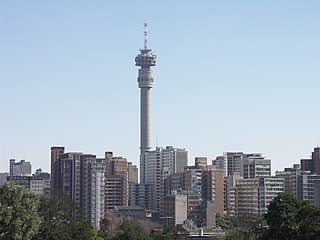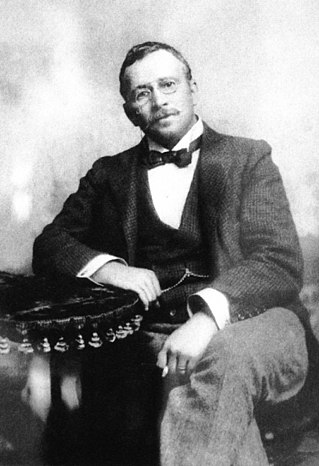
Hillbrow is an inner city residential neighbourhood of Johannesburg, Gauteng Province, South Africa. It is known for its high levels of population density, unemployment, poverty, prostitution and crime.

Johannesburg is a large city in Gauteng Province of South Africa. It was established as a small village controlled by a Health Committee in 1886 with the discovery of an outcrop of a gold reef on the farm Langlaagte. The population of the city grew rapidly, becoming a municipality in 1898. In 1928 it became a city making Johannesburg the largest city in South Africa. In 2002 it joined ten other municipalities to form the City of Johannesburg Metropolitan Municipality. Today, it is a centre for learning and entertainment for all of South Africa. It is also the capital city of Gauteng.

Barney Barnato, born Barnet Isaacs, was a British Randlord and diamond magnate, one of the entrepreneurs who gained control of diamond mining, and later, gold mining in South Africa from the 1870s up to World War I. He is perhaps best remembered as being a rival of Cecil Rhodes.
Parktown is a wealthy suburb of Johannesburg, South Africa, the first suburb north of the inner city. It is affectionately known as one of the Parks, others including Parkview, Parkwood, Westcliff, Parktown North, Parkhurst and Forest Town. Parktown is one of Johannesburg's largest suburbs, neighbouring Hillbrow, Braamfontein and Milpark to the South; Berea and Houghton to the East; Killarney and Forest Town to the North, and Westcliff, Melville and Richmond to the West. Originally established by the Randlords in the 1890s, Parktown is now home to many businesses, hospitals, schools, churches and restaurants, whilst still maintaining quiet residential areas. It is also home to three of the five campuses of the University of the Witwatersrand including the education campus, medical school and Wits Business School. It is located in Region F of the City of Johannesburg Metropolitan Municipality.
Belgravia is a suburb of Johannesburg, South Africa. It is located in Region F of the City of Johannesburg Metropolitan Municipality.
Berea is an inner city neighbourhood of Johannesburg, in the South African province of Gauteng. It is east and adjacent to the Johannesburg CBD. It is located in Region F of the City of Johannesburg Metropolitan Municipality.
Fairview is a suburb of Johannesburg, South Africa. It is a small suburb found on the eastern edge of the Johannesburg central business district (CBD), with the suburb of Troyeville to the north, Jeppestown to the south and Malvern to its east. Commissioner Street, the main street in the CBD, has its eastern end in the suburb. It is located in Region F of the City of Johannesburg Metropolitan Municipality.
Lorentzville is a suburb of Johannesburg, South Africa. It is a small suburb found on the eastern edge of the Johannesburg central business district (CBD), tucked between the suburbs of Bertrams and Judith's Paarl, with Troyeville to the south. It is located in Region F of the City of Johannesburg Metropolitan Municipality.
Malvern is a suburb of Johannesburg, South Africa. Situated east of the Johannesburg CBD, it lies south of Kensington and north of the industrial suburb of Denver. It is located in Region F of the City of Johannesburg Metropolitan Municipality and lies just west of Bedfordview in the City of Ekurhuleni Metropolitan Municipality.
Louis Botha Avenue is a major street in Johannesburg, South Africa. Originally part of the main road between central Johannesburg and Pretoria, it runs along through the north-eastern parts of the city from Hillbrow to Sandton, passing through numerous older suburbs, including Houghton and Orange Grove, before it becomes the Pretoria Main Road (R101) which passes the Alexandra Township and continues to Midrand and Pretoria.

The Joel family of England was headed by three brothers, Jack, Woolf and Solomon, who made a fortune in diamond and gold mining in South Africa. Their father was Joel Joel (1836–1893) and their mother Catherine "Kate" Joel née Isaacs (1840–1917), a sister of Barnett Isaacs, later known as Barney Barnato.
Randlords were the capitalists who controlled the diamond and gold mining industries in South Africa from the 1870s up to World War I.

Solomon Barnato "Solly" Joel, born in London, England, moved to Cape Colony in the 1880s where he made his fortune in connection with diamonds, later becoming a financier with interests in mining, brewing and railways.
JCI or Johannesburg Consolidated Investment Co. Ltd. was founded in 1889 by the British entrepreneur Barney Barnato. JCI was a major force in South African mining for over 100 years. Using his investments in the Kimberley diamond fields, particularly his 25% share in De Beers, Barnato foresaw the value of and invested in the potential of the Witwatersrand gold mines. At first he bought small but rich mines near Germiston – the New Primrose, named after his daughter, and others in the same region.

The mansions of Parktown are an important part of the history of the city of Johannesburg. They were the homes of the Randlords, accountants, military personnel and other influential residents of early Johannesburg, dating back as early as the 1890s. The first of these mansions, Hohenheim was designed by Frank Emley and was built for Sir Lionel Phillips and his wife Lady Florence Phillips. The name Hohenheim had been used originally by Hermann Eckstein, one of the first Rand Lords to name his house after the place of his own birth. When Phillips became the head of Eckstein & Co, he moved in to Eckstein's house but due to the expansion of the city decided to build the new Hohenheim in an enviable site further from the mine workings. Sir Lionel Phillips was banished from the Republic for his involvement in the Jameson Raid. It is perhaps fitting that the next occupant of this famous house was none other than Sir Percy Fitzpatrick, the author of the best selling book 'Jock of the Bushveldt'. The house was demolished but a plaque remains in honor of this building.

Barnato Park High School is a co-educational school located in Berea, Johannesburg, South Africa. It was built on the site of the mansion that had been designed for Barney Barnato, the mining millionaire.
Linksfield is a suburb of Johannesburg, South Africa. It is a suburb lying north-east of the Johannesburg CBD and is surrounded southerly by Linksfield Ridge, easterly by Linksfield North and Bedford, St Andrews and Senderwood. Linksfield itself is located in Region E of the City of Johannesburg Metropolitan Municipality. On the southerly side and over the ridge are the areas of Cyrildene, Observatory and Morninghill, but these suburbs are not visible to Linksfield as they are hidden behind the Linksfield Ridge.
Bezuidenhout Valley is a suburb of Johannesburg, South Africa. The area lies to the east of the Johannesburg CBD and is surrounded by the suburbs of Kensington to the south and Observatory to the north. It is located in Region E of the City of Johannesburg Metropolitan Municipality. It is colloquially known as the Bez Valley.
Parlshoop is a suburb of Johannesburg, South Africa, around 4 km west of City Hall. It borders Langlaagte to the north and Homestead Park to the northeast. The name comes from the village of Paarlshoop, the oldest private township on the Witwatersrand.









